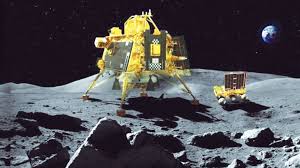

Click to check Stock Market-related Articles – LINK
India Poised for Historic South Pole Moon Landing
India is on the verge of achieving its first-ever landing on the moon’s south pole, a significant achievement that comes shortly after Russia’s Luna 25 mission experienced a setback with its landing attempt.
India’s ambitious lunar program has positioned the nation at the forefront of space exploration, with advanced technology and strategic planning propelling it toward this groundbreaking milestone.
A Remarkable Milestone in Lunar Exploration
India’s space agency, the Indian Space Research Organisation (ISRO), has been relentlessly pursuing its goal of landing on the moon’s south pole. This mission, known as Chandrayaan-3, represents a crucial step in India’s space exploration journey. With a focus on innovative engineering and precise execution, the country aims to showcase its prowess in space technology and research.
Overcoming Challenges and Setbacks
The road to lunar exploration has not been without its challenges. Russia’s recent Luna 25 mission encountered difficulties during its landing attempt on the moon’s south pole. However, setbacks such as this are not uncommon in the realm of space exploration. India’s lunar program has drawn lessons from past missions and has meticulously prepared to avoid similar pitfalls.
Advancing Lunar Technology
Chandrayaan-3 is poised to demonstrate India’s advancements in lunar technology. The mission incorporates cutting-edge instruments and scientific tools designed to analyze the moon’s surface composition, geology, and topography. The insights gained from this endeavor could contribute significantly to humanity’s understanding of the moon’s history and evolution.
Key Strategies for Successful Lunar Exploration
The success of Chandrayaan-3 hinges on several key strategies, including:
- Precise landing technology: India will use advanced landing systems to ensure a soft and controlled touchdown on the lunar surface.
- Robust communication infrastructure: A reliable communication link with the lunar module is essential. India has developed a robust communication infrastructure to facilitate real-time data transmission during critical mission phases.
- Scientific collaboration: International collaboration plays a pivotal role in space exploration. India has actively engaged with other nations, fostering collaboration in research, technology, and mission planning.
- Iterative approach: Learning from setbacks and continuously iterating on mission plans is a key strategy. India’s lunar program has embraced this approach, refining its techniques based on past experiences.
- Public engagement: Sharing the excitement of space exploration with the public fosters interest and support. India’s space agency has undertaken initiatives to engage citizens and inspire the next generation of scientists and engineers.
Looking Ahead
As India’s Chandrayaan-3 mission approaches its historic lunar landing, anticipation and enthusiasm are running high. The successful execution of this endeavor will not only mark a significant achievement for India but will also contribute to the global body of lunar knowledge.
With determination, innovation, and strategic planning, India is poised to take a giant leap forward in the realm of space exploration.
Conclusion
India’s imminent lunar landing on the moon’s south pole is a testament to the nation’s dedication to space exploration. By harnessing the power of advanced technology, strategic planning, and international collaboration, India is on the cusp of achieving a remarkable feat that will further propel humanity’s understanding of the universe.
==================================
🔗 Join our Telegram Channel! 🔗
📲 Click on the link below to join:
🚀 Stay updated with the latest market trends and insights. 📈📊
===================================
Some related Questions and Answers from this Article:-
Question: How has India’s lunar program overcome setbacks in the past?
Answer: India’s lunar program has overcome setbacks in the past by learning from its mistakes and by continuously iterating on its mission plans. For example, the Chandrayaan-1 mission, which was India’s first lunar mission, experienced a number of technical problems. However, India’s space agency, the Indian Space Research Organisation (ISRO), learned from these problems and was able to successfully launch and operate the Chandrayaan-2 mission.
Question: What are the scientific benefits of landing on the moon’s south pole?
Answer: The scientific benefits of landing on the moon’s south pole are significant. The south pole is thought to be home to water ice, which could be a valuable resource for future space exploration. Additionally, the south pole is also thought to be a good place to study the moon’s geology and evolution.
Question: What are the future plans for India’s lunar program?
Answer: India’s space agency has ambitious plans for its lunar program. In addition to Chandrayaan-3, India is also planning to launch a number of other lunar missions in the coming years. These missions will focus on studying the moon’s surface, subsurface, and atmosphere.
Question: What are the challenges and opportunities of international collaboration in space exploration?
Answer: International collaboration is essential for space exploration. By working together, countries can share resources and expertise, and they can also pool their knowledge and experience. This can help to reduce costs and risks, and it can also help to accelerate the pace of discovery.
Question: What are the ethical considerations of space exploration?
Answer: Space exploration raises a number of ethical considerations, such as the potential for environmental damage, the exploitation of resources, and the impact on indigenous cultures. It is important to carefully consider these issues before embarking on space exploration.
In Hindi –
भारत दक्षिण ध्रुव पर Moon पर उतरने के लिए तैयार है
भारत Moon के दक्षिण ध्रुव पर अपना पहला-कभी उतरने के लिए तैयार है, जो एक महत्वपूर्ण उपलब्धि है जो रूस के लूना 25 मिशन के बाद आई है, जिसने अपने लैंडिंग प्रयास में बाधा का सामना किया था।
भारत की महत्वाकांक्षी Moon कार्यक्रम ने देश को अंतरिक्ष अन्वेषण के अग्रणी के रूप में स्थापित किया है, जिसमें उन्नत तकनीक और रणनीतिक योजना इस आधारभूत मील के पत्थर की ओर अग्रसर है।
Moon अन्वेषण में एक उल्लेखनीय मील का पत्थर
भारतीय अंतरिक्ष अनुसंधान संगठन (इसरो) ने Moon के दक्षिण ध्रुव पर उतरने के अपने लक्ष्य का पीछा करने के लिए कड़ी मेहनत की है। इस मिशन, जिसे चंद्रयान-3 के रूप में जाना जाता है, भारत के अंतरिक्ष अन्वेषण यात्रा में एक महत्वपूर्ण कदम है। नवीन इंजीनियरिंग और सटीक निष्पादन पर ध्यान केंद्रित करते हुए, देश अंतरिक्ष प्रौद्योगिकी और अनुसंधान में अपनी प्रवीणता का प्रदर्शन करना चाहता है।
चुनौतियों और बाधाओं को दूर करना
Moon अन्वेषण का रास्ता चुनौतियों से भरा नहीं रहा है। रूस के हालिया लूना 25 मिशन ने Moon के दक्षिण ध्रुव पर अपने लैंडिंग प्रयास में कठिनाइयों का सामना किया। हालांकि, इस तरह की बाधाएं अंतरिक्ष अन्वेषण के क्षेत्र में असामान्य नहीं हैं। भारत के Moon कार्यक्रम ने पिछले मिशनों से सबक सीखा है और समान कमियों से बचने के लिए सावधानीपूर्वक तैयारी की है।
Moon प्रौद्योगिकी को आगे बढ़ाना
चंद्रयान-3 भारत की Moon प्रौद्योगिकी में प्रगति को प्रदर्शित करने के लिए तैयार है। यह मिशन उन्नत उपकरणों और वैज्ञानिक उपकरणों को शामिल करता है जो Moon की सतह के संरचना, भूविज्ञान और स्थलाकृति का विश्लेषण करने के लिए डिज़ाइन किए गए हैं। इस प्रयास से मानवता के Moon के इतिहास और विकास की समझ में महत्वपूर्ण योगदान हो सकता है।
सफल Moon अन्वेषण के लिए महत्वपूर्ण रणनीतियाँ
चंद्रयान-3 की सफलता कई महत्वपूर्ण रणनीतियों पर निर्भर करती है, जिनमें शामिल हैं:
- सटीक लैंडिंग तकनीक: भारत उन्नत लैंडिंग प्रणालियों का उपयोग करेगा ताकि Moon की सतह पर नरम और नियंत्रित टचडाउन सुनिश्चित हो सके।
- मजबूत संचार बुनियादी ढांचा: Moon के मॉड्यूल के साथ एक विश्वसनीय संचार लिंक आवश्यक है। भारत ने महत्वपूर्ण मिशन चरणों के दौरान वास्तविक समय डेटा संचरण को सुविधाजनक बनाने के लिए एक मजबूत संचार बुनियादी ढांचा विकसित किया है।
- वैज्ञानिक सहयोग: अंतरराष्ट्रीय सहयोग अंतरिक्ष अन्वेषण में एक महत्वपूर्ण भूमिका निभाता है। भारत ने अन्य देशों के साथ सक्रिय रूप से सहयोग किया है, अनुसंधान, प्रौद्योगिकी और मिशन योजना में सहयोग को बढ़ावा दिया है।
- पुनरावृत्त दृष्टिकोण: सेटबैक से सीखना और मिशन योजनाओं को लगातार पुनरावृत्त करना एक महत्वपूर्ण रणनीति है। भारत के Moon कार्यक्रम ने इस दृष्टिकोण को अपनाया है, अपने तकनीकों को पिछले अनुभवों के आधार पर परिष्कृत किया है।
- सार्वजनिक जुड़ाव: अंतरिक्ष अन्वेषण के रोमांच को जनता के साथ साझा करना रुचि और समर्थन को बढ़ावा देता है। भारत के अंतरिक्ष एजेंसी ने नागरिकों को शामिल करने और अगली पीढ़ी के वैज्ञानिकों और इंजीनियरों को प्रेरित करने के लिए पहल की है।








